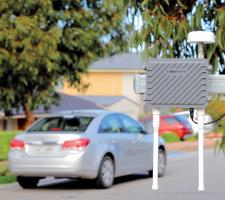
ITS associations from three European countries shared ambitious plans for Cooperative ITS (C-ITS) during a presentation at Intertraffic.
Martin Russ from
ITS Norway’s Trond Hovland highlighted roles for C-ITS in Nordic conditions, citing live tests with vehicles acting as early sensors of slippery road states and alerting following traffic at least 1km ahead of a danger spot – as well as alerting maintenance crews.
Finally, Roman Srp, network chair and executive director of ITS Czech Republic and Slovakia, introduced the first Czech C-ITS project, BaSIC. The project is testing systems for giving alerts of stationary and slow-moving vehicles, approaching emergency responders, traffic jams and roadworks. The country’s ambition, he said, was to become “one of the frontrunners in EU C-ITS activity”.
- <%$Linker:
2 External <?xml version="1.0" encoding="utf-16"?><dictionary /> 0 0 0 oLinkInternal ITS UK ITS United Kingdom false #ITS-UK true false %> - <%$Linker:
2 External <?xml version="1.0" encoding="utf-16"?><dictionary /> 0 0 0 oLinkInternal ITS Australia ITS AUs false #ITS-Australia true false %> - <%$Linker:
2 External <?xml version="1.0" encoding="utf-16"?><dictionary /> 0 0 0 oLinkInternal EU EU Call false #ITS-Eu true false %>
ITS UK
Countries boasting that legal autonomous vehicles will become a regular feature on their roads within the next few years are straying “far from the case”,
In an informal briefing of the House of Commons (Lower House) Transport Select Committee, a high-profile delegation stressed the “numerous obstacles” standing in the path of achieving such claims.
Before being able to deploy autonomous vehicles together with conventional ones on any national road network, crucial issues such as standards, legality, safety, assurance and reliability need to be addressed. Although the UK autonomous vehicle industry has many “good stories to tell”, it also acknowledges the significant barriers that need to be overcome, the parliamentarians heard.
Developments in connected and automated vehicle technology were among highlights at
Justin Passaportis, of GoGet CarShare updated members on the Australian Driverless Vehicle Initiative, which has its national centre of excellence based in the city.
Driverless vehicles, he said, would reduce the role of human error in road crashes, which cost the Australian economy AUS$27bn (US$20.5bn) a year, and levels of congestion, which costs it AU$30bn (US$23bn) a year.
Dr Paul Gray, chief executive of Adelaide-based
This can detect, for example, the risk of rear-end collisions between buses coming off the city’s O-bahn guided busway, onto mixed-traffic streets, and other buses already there - and warn drivers accordingly. The system also monitors following distances.
EU’s eCall helped on its way
The EU requires all new cars bought in Member States from April 2018 to be equipped with the system which will automatically dial for emergency aid after a collision. In preparation for drafting the new Belgian regulations the association set up a dedicated working group, leading a public consultation process to develop early policy documentation and organising systematic feedback on the proposed legislative content. It has also contributed to the accreditation and compliance process for the provision of eCall equipment and services, which it believes will make the new law operational earlier than might otherwise have been the case.
Trials have taken place at the Belgian eCall pilot site in the Greater Brussels area, using existing software and operational systems as far as possible.
Royal assent for the enabling law is expected in summer 2016.






